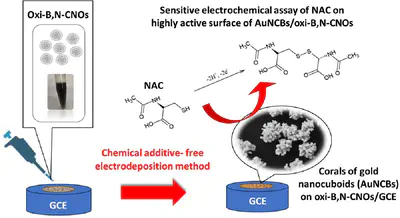Exploitation of carbon surface functionality toward additive‐free formation of gold nanocuboids suitable for sensitive assay of N‐acetylcysteine in pharmaceutical formulations

Abstract
Chemical additive and physical template-free electrochemical methods to prepare carbon-supported nanostructures of catalyst metals represent an emerging technology. Formation of the metal nano/microstructures depends not only on the electrochemical method/parameters but also on the nature of the underlying carbon material. Here, we present a comparative evolution of unevenly distributed coral-like aggregates of nanocuboid-shaped gold nanostructures (AuNCBs) on the oxidised form of boron, nitrogen-doped carbon nanoonions (oxi-B,N-CNO) compared to evenly distributed bud-like aggregates of cubic shaped gold nanostructures on bare glassy carbon electrode under a similar electrochemical approach. The synthesis method provided the best availability of the surface active sites, whereas the shape of the structures showed a direct influence of both outer-sphere and inner-sphere electron transfer reactions. The higher sensitivity of AuNCBs@oxi-B,N-CNO compared to individual components and bare carbon/gold electrodes toward the inner-sphere oxidative reaction of N-acetyl-L-cysteine (NAC) was exploited in order to develop an electrochemical assay method with sensitivity and linear dynamic range of (4.70 ± 0.25) × 10−4 C∙cm−2∙mM−1 and 0.2–2.5 mM, respectively in acetate buffer (pH 4.45). Furthermore, the sensor design was deployed in the quantitation of NAC in pharmaceutical preparations, resulting in 89%–106% recovery.